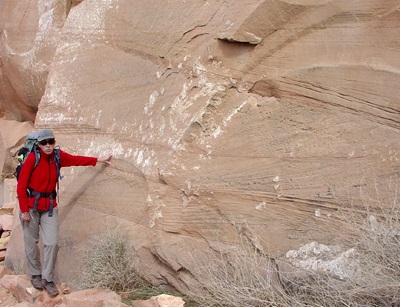Grand Canyon Sandstone and the Genesis Flood
For many years, the rock layers in the Grand Canyon have been proclaimed as evidence for long ages. Biblical creation scientists have shown that such thinking is inaccurate and misleading. However, one of the more interesting challenges is the layer of Coconino Sandstone.
Unifomitarian geologists maintain that this layer is the product of gradual deposition by wind-blown sand and desert conditions. Some hard science supporting the Genesis Flood and rapid deposition by water (as well as the question about how the sand traveled that far, as the Cocconino Sandstone is mighty big) should have disabused them of that notion, but they still keep their faith. Another problem secularists have is the presence of footprints, which research shows had to be made in watery conditions.
 |
| Crossbedding in the Coconino Sandstone along the Kaibab Trail of Grand Canyon's South Rim Credit: USGS (usage does not imply endorsement of site contents) |
What do these rock layers in Grand Canyon mean? What do they tell us about the earth’s past? For example, how did all the sand in this Coconino Sandstone layer and its equivalents get to where it is today?
To answer these questions geologists study the features within rock layers like the Coconino Sandstone, and even the sand grains themselves. An easily noticed feature of the Coconino Sandstone is the distinct cross layers of sand within it called cross beds
. . .
The Coconino Sandstone is also noted for the large number of fossilized footprints, usually in sequences called trackways. These appear to have been made by four-footed vertebrates moving across the original sand surfaces. . . . These fossil footprint trackways were compared to the tracks made by reptiles on desert sand dunes,4 so it was then assumed that these fossilized footprints in the Coconino Sandstone must have been made in dry desert sands which were then covered up by wind-blown sand, subsequent cementation forming the sandstone and fossilizing the prints.To learn more, you can read the rest of this 1992 article by clicking on " Startling evidence for Noah’s Flood — Footprints and sand ‘dunes’ in a Grand Canyon sandstone!" But wait, there's more! Regular readers may suspicion that we rode this trail before. Well, sort of. A similar treatment of the subject with some additional (and more recent) information can be found at "Coconino Sandstone Myths Debunked".